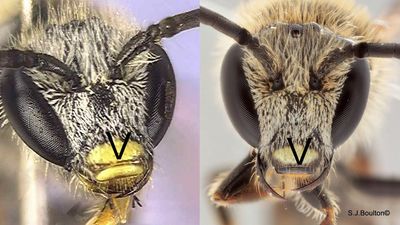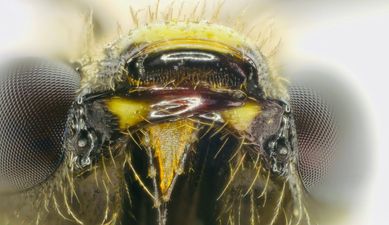Found throughout Britain, from the Isles of Scilly and Kent north to the north coast of the Scottish mainland. Also found in the Channel Islands, the Isle of Man and parts of Ireland
Found across the Palaearctic region from Britain to Japan, reaching north to northern Finland. In the south of its range, it is mostly montane, occurring up to 1800 metres: Iberia, south to Serra Estrela; Corsica; Italy, Monte Pollino; the high mountains of Greece south to Taygetos; north-east Turkey but south to Toros, Bolkar Daglari (A W Ebmer, pers. comm.).
This species is not regarded as scarce or threatened.

Males of Lasioglossum calceatum and Lasioglossum albipes are almost impossible to separate to species from photographs without a view of the colour of the labrum. The labrum is a small oval plate located below the clypeus on the front of the head, and it is often "folded up" underneath the head in front of the mandibles making it difficult to see. Both species have yellow and black markings on the clypeus, so it is important to be sure that you are looking at the labrum itself, not the clypeus. The following photos show the faces of males of both species with the labrum "unfolded" and visible.The Lasioglosum albipes male, on the left, has a yellow labrum below the clypeus. The Lasioglossum calceatum male, on the right, has a black labrum below the clypeus.

If the labrum is folded away, then a photo of the head from underneath is required to make an ID. This is a Lasioglossum calceatum male with the oval black labrum "folded away" under the head in front of the mandibles. The yellow colouring visible in front of the labrum is the lower part of the clypeus. Photos credit Andy Kaey
Found in most habitats, and can be abundant in more open, dry areas.
The female is found on the wing from mid-March to early October and the male from late June to end October, at least in the south. In the northern part of the range the flight period may be partly contracted.
This is a primitively eusocial mining bee in the southern part of its range. In northerly latitudes it may be solitary. The nest is constructed in short turf or other open situations in the sun, but seems not to be found in large aggregations. The nest is usually founded by one female but rarely more than one are found. Here the dominant individual, usually the largest, becomes the queen and the others then serve as workers. In the more typical situation, the lone foundress female digs the length of all the main burrow, which is almost vertical. She then constructs a short lateral tunnel some distance from the bottom, which leads to a comb-like cell cluster surrounded by an air chamber. The lone female builds 4–7 cells, in which she rears smaller workers with under-developed ovaries and sometimes one or two males. The workers take over the foraging, helping rear a brood of males and sexual females. In the south of its range, there may be two broods of workers (Plateaux-Quénu, 1992).
The females and males will visit a wide variety of flowers for nectar.
There are no known Sphecodes specifically cleptoparasitic on Lasioglossum calceatum, although more generalist Sphecodes may parasitise this species.
2022


